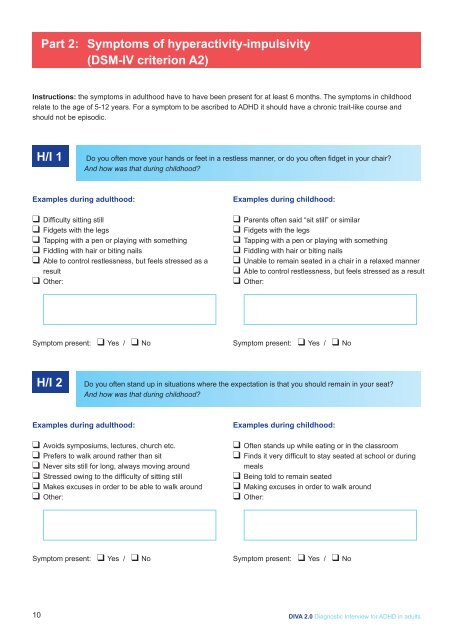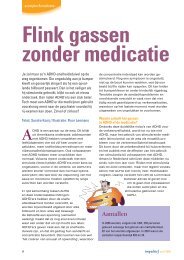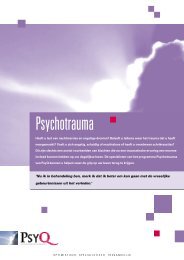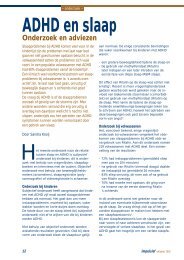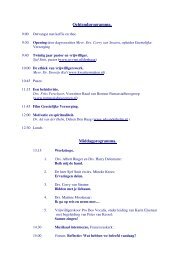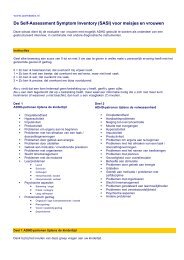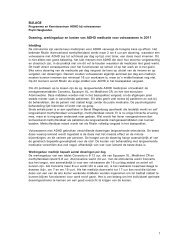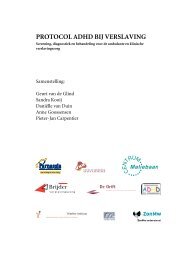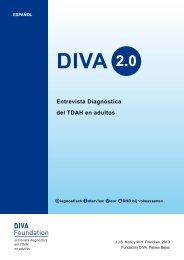Diagnostic Interview for ADHD in adults (DIVA) - PsyQ
Diagnostic Interview for ADHD in adults (DIVA) - PsyQ
Diagnostic Interview for ADHD in adults (DIVA) - PsyQ
You also want an ePaper? Increase the reach of your titles
YUMPU automatically turns print PDFs into web optimized ePapers that Google loves.
Part 2: Symptoms of hyperactivity-impulsivity<br />
(DSM-IV criterion A2)<br />
Instructions: the symptoms <strong>in</strong> adulthood have to have been present <strong>for</strong> at least 6 months. The symptoms <strong>in</strong> childhood<br />
relate to the age of 5-12 years. For a symptom to be ascribed to <strong>ADHD</strong> it should have a chronic trait-like course and<br />
should not be episodic.<br />
H/I 1<br />
H/I 2<br />
Do you often move your hands or feet <strong>in</strong> a restless manner, or do you often fidget <strong>in</strong> your chair?<br />
And how was that dur<strong>in</strong>g childhood?<br />
Examples dur<strong>in</strong>g adulthood:<br />
❑ Difficulty sitt<strong>in</strong>g still<br />
❑ Fidgets with the legs<br />
❑ Tapp<strong>in</strong>g with a pen or play<strong>in</strong>g with someth<strong>in</strong>g<br />
❑ Fiddl<strong>in</strong>g with hair or bit<strong>in</strong>g nails<br />
❑ Able to control restlessness, but feels stressed as a<br />
result<br />
❑ Other:<br />
Symptom present: ❑ Yes / ❑ No<br />
Do you often stand up <strong>in</strong> situations where the expectation is that you should rema<strong>in</strong> <strong>in</strong> your seat?<br />
And how was that dur<strong>in</strong>g childhood?<br />
Examples dur<strong>in</strong>g adulthood:<br />
❑ Avoids symposiums, lectures, church etc.<br />
❑ Prefers to walk around rather than sit<br />
❑ Never sits still <strong>for</strong> long, always mov<strong>in</strong>g around<br />
❑ Stressed ow<strong>in</strong>g to the difficulty of sitt<strong>in</strong>g still<br />
❑ Makes excuses <strong>in</strong> order to be able to walk around<br />
❑ Other:<br />
Symptom present: ❑ Yes / ❑ No<br />
Examples dur<strong>in</strong>g childhood:<br />
❑ Parents often said “sit still” or similar<br />
❑ Fidgets with the legs<br />
❑ Tapp<strong>in</strong>g with a pen or play<strong>in</strong>g with someth<strong>in</strong>g<br />
❑ Fiddl<strong>in</strong>g with hair or bit<strong>in</strong>g nails<br />
❑ Unable to rema<strong>in</strong> seated <strong>in</strong> a chair <strong>in</strong> a relaxed manner<br />
❑ Able to control restlessness, but feels stressed as a result<br />
❑ Other:<br />
Symptom present: ❑ Yes / ❑ No<br />
Examples dur<strong>in</strong>g childhood:<br />
❑ Often stands up while eat<strong>in</strong>g or <strong>in</strong> the classroom<br />
❑ F<strong>in</strong>ds it very difficult to stay seated at school or dur<strong>in</strong>g<br />
meals<br />
❑ Be<strong>in</strong>g told to rema<strong>in</strong> seated<br />
❑ Mak<strong>in</strong>g excuses <strong>in</strong> order to walk around<br />
❑ Other:<br />
Symptom present: ❑ Yes / ❑ No<br />
10 <strong>DIVA</strong> 2.0 <strong>Diagnostic</strong> <strong>Interview</strong> <strong>for</strong> <strong>ADHD</strong> <strong>in</strong> <strong>adults</strong>


